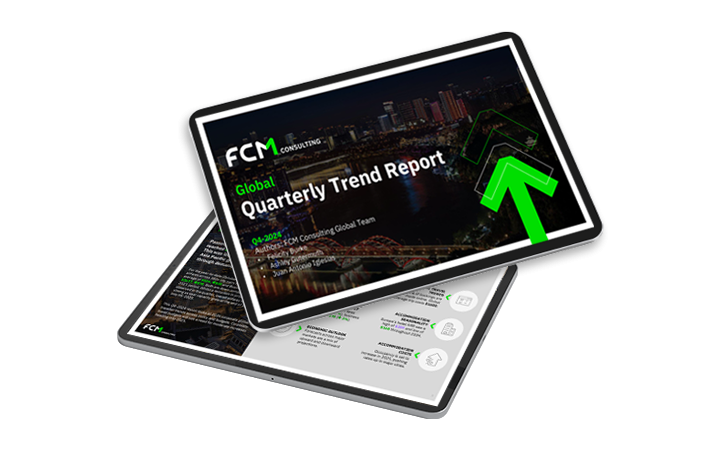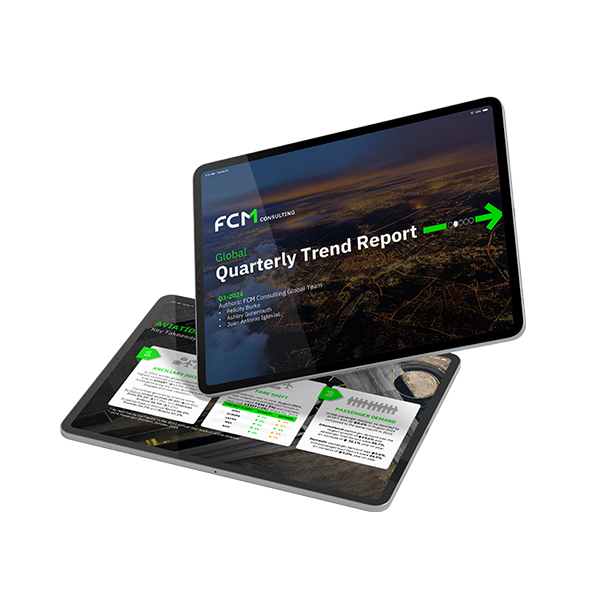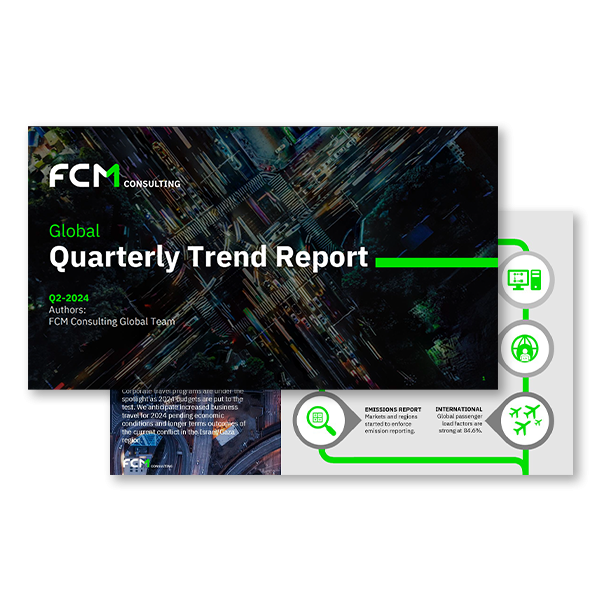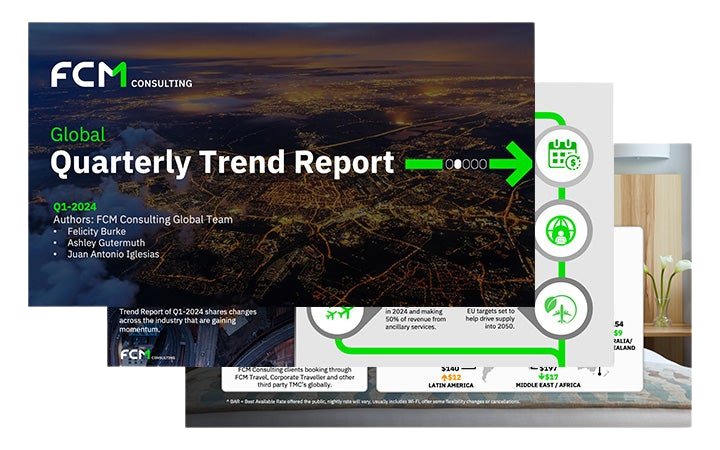FCM Consulting Insights Report: Trends & Strategies for H1-2026
FCM's Consulting's new-look insights report is here.
This report covers everything from air and ground movements to traveller behaviour and external events influencing business travel. If you oversee the big picture, make the bookings, or are just curious about what’s ahead, this twice-yearly insights report is designed to deliver data and direction.
Backed by corporate travel statistics, trends, and expert voices, this is your corporate travel forecast.
Latest business travel trends
The first edition of our newly reshaped report focuses on five trending topics in corporate travel right now:
- AI in corporate travel, helpful or hype? Understand where automation can add value in travel programs, and what’s better left to humans.
- Risk management during unstable times. Gain expert strategies for preparing, responding to, and futureproofing during geopolitical tensions, supply chain disruptions, and sudden changes.
- Airline outlook. Stay informed about what's happening in the skies, including capacity, infrastructure, fuel, supply, and demand.
- Hotel trends and rate predictions. Discover what's driving hotel pricing and the markets that are decreasing vs. increasing.
- Regional watchlist. Europe is torn between economy and sustainability. America is managing instability. Asia is eyeing off new destinations. Every region has its own realities; this section zooms in on each.
Previous corporate travel trend reports

Corporate travel trends in Q4-2024
Business travel surged late last year, but so did prices and pressure. Airlines pushed capacity, hotels filled up, and travel managers had to think on their feet.
In this report, you'll find:
- Online self-service rose, with 61% of bookings made online.
- Seat availability was forecasted to rise with 38 million extra seats on offer in 2025.
- Hotel prices and occupancy rose in key cities, while some regions bucked the trend.
- Average trip costs hovered between $1,600 and $1,800, with airfares making up most.
- Domestic flights were popular, while economy and business fares dipped.

Corporate travel trends in Q3-2024
While economic uncertainty remains around the world, 2024 has continued to be a strong year for the travel industry. With flights 86.2% full in August 2024 and prices stabilizing for economy and business fares in Q3-2024, airlines are now looking to further grow services and schedules to meet demand in 2025.
Key takeaways from Q3-2024:
- Global airline capacity is expected to reach new heights in H1-2025.
- Airline income from ancillaries (bags, meals, etc.) increased 32.5% in 2023 vs 2022.
- Europe and the Americas saw hotel rates increase, while decreases were noted in APAC and Middle East & Africa.
- Car rental global average daily rates decreased 30% in Q3-2024 vs the same quarter last year.

What story does Q2-2024 tell us about corporate travel?
Global airline passenger demand is up 9.1%, the average room rate is rising, and economic uncertainty underpins everything as we move into H2-2024. However, data shows that the first half of 2024 created positive momentum.
Key takeaways from Q2-2024:
- NDC made up 21.5% of total transactions in June 2024
- Global fares rose by 15% for economy class and 11% in business class
- Hotel occupancy was forecast to reach 70% in July
- 11 of the top corporate airlines are forecast to exceed 2019 levels

Download for more Q1-2024 travel trends
Despite increasing demand, companies are not ready to increase corporate travel budgets. Business travelers are out on the road meeting with clients and colleagues, and budgets are being maximized with a combination of early bookings and more days away.
- Economic outlook for 2024 is positive, but faces uncertainty
- Rising demand is increasing supplier confidence
- Seat capacity forecasted to increase +3.5% over 2019 from May to December 2024 (North America leading the way with +9% increase)
About FCM Consulting
FCM Consulting supports organisations across the world to navigate complex travel environments. The team of experts assists global businesses with everything from air and hotel programme optimisation to sustainability strategies, outsourced travel resources, supplier sourcing, benchmarking, and change management.
Bringing together a mix of market intelligence, on-the-ground insights, and years of experience, the minds behind the report include Jo Lloyd, Global Director Consulting; Felicity Burke, Head of Consulting Asia Pacific; Ashley Gutermuth, Head of Consulting Americas; Juan Antonio Iglesias, Head of Consulting EMEA; Jason Kramer, Senior Air Consultant; and Rachel Newns, Global Hotel Practice Lead.
Frequently Asked Questions
-
What is the FCM Consulting Insights Report?
It’s a twice-yearly snapshot of what’s shaping the world of corporate travel, created by FCM Consulting’s team of experts. Think of it as your guide for business travel trends across the globe, insights on what’s happening in the airline and accommodation space, and more.
-
What topics does the FCM Consulting Insights Report cover?
The report will consistently cover external events that impact corporate travel, booking behaviour, aviation demand and pricing, accommodation capacity, average room rates, and ground transportation movements. You will also find most statistics broken down by region, allowing you to get a more tailored view.
-
Who is the FCM Consulting Insights Report for?
Anyone with a stake in business travel. Including travel managers, procurement leads, finance decision-makers, personal assistants (PAs) and executive assistants (EAs) managing bookings, human resources (HRs), and suppliers who want to better understand buyer behaviour. If corporate travel affects your role in some way, shape, or form, this report has something for you.
-
Is the data in the FCM Consulting Insights Report global?
Yes. The report covers global travel trends with regional deep dives into North America, Latin America, Europe, Asia, Australia and New Zealand, and Middle East and Africa. We aim to give a balanced global view without favouring one market over another.
-
How is the information gathered?
The report is built from a mix of Flight Centre Travel Group and FCM Travel’s proprietary travel data, industry data sources, market research, and conversations with consultants, suppliers, and experts around the globe.